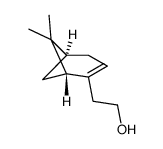(-)-NOPOL

(-)-NOPOL structure
|
Common Name | (-)-NOPOL | ||
|---|---|---|---|---|
| CAS Number | 35836-73-8 | Molecular Weight | 166.26000 | |
| Density | 0.978g/cm3 | Boiling Point | 230ºC | |
| Molecular Formula | C11H18O | Melting Point | N/A | |
| MSDS | Chinese USA | Flash Point | 98.9ºC | |
| Symbol |

GHS07 |
Signal Word | Warning | |
|
Acetyltransferase p300/CBP associated Factor (PCAF) regulates crosstalk-dependent acetylation of histone H3 by distal site recognition.
ACS Chem. Biol. 10(1) , 157-64, (2015) Epigenetic regulation is directed, in part, by the correlated placement of histone post-translational modifications, but the mechanisms controlling correlated modifications are incompletely understood. Correlations arise from crosstalk among modifications and... |
|
|
Development of novel formulations to enhance in vivo transdermal permeation of tocopherol.
Acta. Pharm. 64(3) , 299-309, (2014) Tocopherol represents a big challenge for transdermal permeation owing to its extreme hydrophobicity and large molecular mass. The aim of the present study was to develop alpha-tocopherol (T) topical formulations and evaluate their ex vivo and in vivo permeat... |
|
|
Kuwanon V inhibits proliferation, promotes cell survival and increases neurogenesis of neural stem cells.
PLoS ONE 10(2) , e0118188, (2015) Neural stem cells (NSCs) have the ability to proliferate and differentiate into neurons and glia. Regulation of NSC fate by small molecules is important for the generation of a certain type of cell. The identification of small molecules that can induce new ne... |
|
|
Differentiation of human umbilical cord matrix mesenchymal stem cells into neural-like progenitor cells and maturation into an oligodendroglial-like lineage.
PLoS ONE 9(10) , e111059, (2014) Mesenchymal stem cells (MSCs) are viewed as safe, readily available and promising adult stem cells, which are currently used in several clinical trials. Additionally, their soluble-factor secretion and multi-lineage differentiation capacities place MSCs in th... |
|
|
Biocompatible, biodegradable and porous liquid crystal elastomer scaffolds for spatial cell cultures.
Macromol. Biosci. 15(2) , 200-14, (2015) Here we report on the modular synthesis and characterization of biodegradable, controlled porous, liquid crystal elastomers (LCE) and their use as three-dimensional cell culture scaffolds. The elastomers were prepared by cross-linking of star block-co-polymer... |
|
|
Development of antibodies for determination of alkylresorcinol metabolites in human urine and elucidation of ELISA cross-reactivity.
J. Immunol. Methods 413 , 12-24, (2014) Alkylresorcinols (ARs) are amphiphilic phenolic lipids and their two main metabolites, 3-(3,5-dihydroxyphenyl)-propanoic acid (DHPPA) and 3,5-dihydroxybenzoic acid (DHBA), can be used as biomarkers of whole grain wheat and rye intake. The aim of this study wa... |
|
|
The biocompatibility of degradable magnesium interference screws: an experimental study with sheep.
Biomed Res. Int. 2015 , 943603, (2015) Screws for ligament reconstruction are nowadays mostly made of poly-L-lactide (PLLA). However, magnesium-based biomaterials are gathering increased interest in this research field because of their good mechanical property and osteoanabolic influence on bone m... |
|
|
Cell-penetrating antimicrobial peptides - prospectives for targeting intracellular infections.
Pharm. Res. 32(5) , 1546-56, (2015) To investigate the suitability of three antimicrobial peptides (AMPs) as cell-penetrating antimicrobial peptides.Cellular uptake of three AMPs (PK-12-KKP, SA-3 and TPk) and a cell-penetrating peptide (penetratin), all 5(6)-carboxytetramethylrhodamine-labeled,... |
|
|
Phenotypic and functional analysis of HL-60 cells used in opsonophagocytic-killing assay for Streptococcus pneumoniae.
J. Korean Med. Sci. 30(2) , 145-50, (2015) Differentiated HL-60 is an effector cell widely used for the opsonophagocytic-killing assay (OPKA) to measure efficacy of pneumococcal vaccines. We investigated the correlation between phenotypic expression of immunoreceptors and phagocytic ability of HL-60 c... |
|
|
Lung deposition and cellular uptake behavior of pathogen-mimicking nanovaccines in the first 48 hours.
Adv. Healthc. Mater. 3(7) , 1071-7, (2014) Pulmonary immunization poses the unique challenge of balancing vaccine efficacy with minimizing inflammation in the respiratory tract. While previous studies have shown that mice immunized intranasally with F1-V-loaded polyanhydride nanoparticles are protecte... |